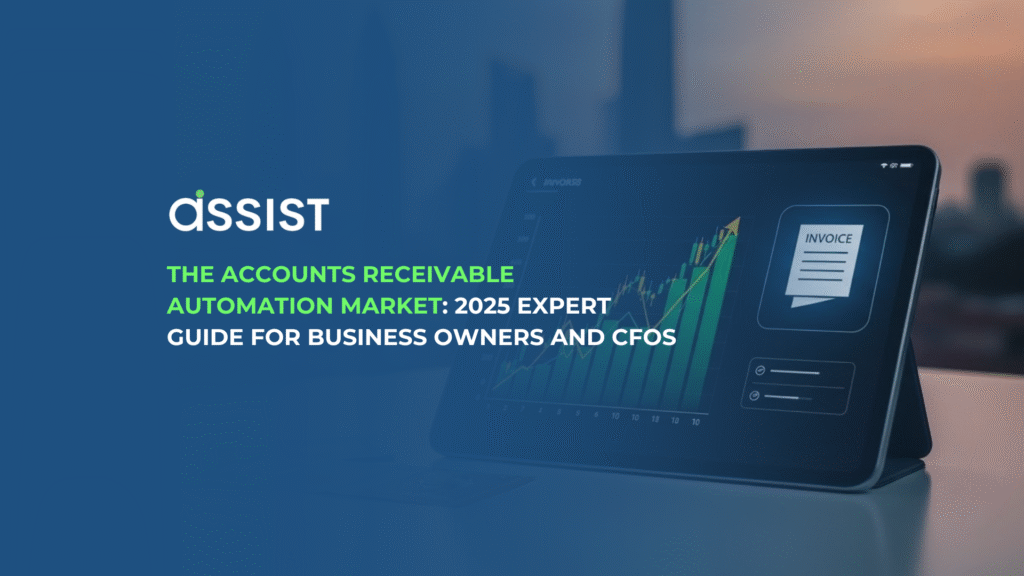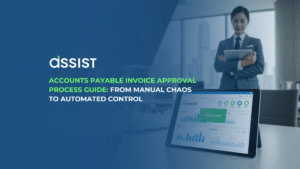The accounts receivable automation market is experiencing explosive, double-digit growth, driven by the global need for superior cash flow visibility, high-yield return on investment, and critical regulatory changes like mandated e-invoicing. This guide details the market’s trajectory, the essential technology powering the transition, and the localized strategies that finance leaders must adopt to capitalize on this financial revolution. Read on to uncover how automation can transform your AR function from a cost center into a powerful strategic asset.
1. Introduction: Why Accounts Receivable (AR) is the New Strategic Frontier
In the dynamic and often turbulent world of corporate finance, one truth remains constant: cash is king. Yet, many businesses, particularly in fast-paced economies, are leaving their crown jewels—their accounts receivable—vulnerable to inefficiency. AR, the lifeblood of working capital, is often shackled by manual, error-prone processes that slow down cash conversion and obscure financial health. This reliance on outdated methods is simply unsustainable in a modern economy driven by speed and precision.
However, a massive shift is underway. The rise of automation technologies is transforming AR from a clerical chore into a strategic asset. Understanding your available solutions is key to growth, and for the savvy business owner or CFO, getting a handle on the burgeoning accounts receivable automation market is no longer optional—it’s an imperative. This market is not just about adopting new software; it’s about securing faster cash flow, improving compliance, and gaining the competitive edge needed to thrive in 2025 and beyond.
2. Macro View: Understanding the Global AR Automation Market Landscape
To truly appreciate the opportunity, we must first recognize the global momentum driving AR automation. The market is experiencing explosive growth, propelled by technological maturity, increased regulatory pressure, and a global focus on financial resilience.
2.1 Market Size, CAGR, and Forecasts: Where the Growth is Heading
Leading industry reports paint a clear picture of rapid expansion. The global AR automation market was valued at approximately USD 3.8 billion in 2023 and is projected to demonstrate a robust Compound Annual Growth Rate (CAGR) of around 12.9%, potentially pushing the market valuation toward USD 8.8 billion by 2030. This upward trend reflects a massive, worldwide acknowledgement that manual AR processes are fundamentally broken and need immediate digital overhaul. For finance leaders, this data confirms that AR automation is a high-growth sector attracting significant investment and innovation—making it a safe and essential bet for future-proofing their operations.
2.2 Key Global Growth Drivers Fueling Market Acceleration
Several powerful forces are converging to fuel this growth:
- Predictive Cash-Flow Visibility: The ability to accurately forecast cash flow is paramount for corporate stability, and automated systems provide the real-time data needed for better decision-making.
- High ROI: A strong driver is the compelling Return on Investment (ROI). Many early adopters report significant reductions in Days Sales Outstanding (DSO) and a reduction in operational costs, creating a persuasive business case.
- Technological Maturity: The biggest factor accelerating this market beyond simple automation is the role of advanced technologies. Agentic AI, for instance, is moving beyond basic task automation to handle complex scenarios like early anomaly detection and intelligent credit risk assessment. To stay competitive, businesses need to be looking at the future of AR and leveraging tools such as sophisticated AI document management for Malaysia: Automate, Comply.
3. Micro Focus: The AR Automation Market in Southeast Asia (Expertise & Localized Insight)
While the global numbers provide the context, the story of AR automation is most dramatic in Southeast Asia. This region is not just participating in this global trend; it is positioned as the fastest-growing regional segment globally. This accelerated growth is largely due to the sheer volume of emerging markets, a rapid pace of digital adoption, and a unique regulatory environment.
3.1 Southeast Asia: The Global Growth Engine and Localized Challenges
The potential for AR automation in Southeast Asia is immense, but so are the localized challenges. Businesses here navigate a complex tapestry of diverse regulatory environments, varied currency handling, and different local payment methods. In mature markets like Singapore, the focus is on hyper-efficiency, while in emerging economies, the driver is often basic digitization and eliminating paper. This complexity demands a solution that is not just powerful, but flexible and locally intelligent.
The transition offers a chance to gain a decisive advantage over competitors still saddled with inefficient legacy systems. For business leaders, this means finding a solution that not only streamlines internal processes but also understands the intricacies of regional financial flows and compliance.
3.2 The Mandate Effect: E-Invoicing as the Ultimate AR Automation Catalyst
Perhaps the most significant, non-negotiable driver of AR automation adoption comes from government mandates. E-Invoicing is quickly becoming the standard, transforming the way businesses transact and manage their records.
Countries are recognizing the benefits of digitized invoicing for tax compliance and economic transparency. In Malaysia, for instance, the LHDN e-invoicing mandate is not merely a technical update—it’s a systemic overhaul. This compliance requirement compels businesses to adopt automation for accurate data capture, validation, and submission. Manual invoicing simply cannot keep pace with the strict standards and deadlines imposed by tax authorities. For this reason, many are turning to automation not just for efficiency, but for regulatory necessity. For a more detailed understanding, a complete guide on transitioning to e-invoice Malaysia is available for further reading.
This regulatory push immediately elevates the need for robust, compliant AR systems, cementing the market’s projected growth rate by providing a non-negotiable adoption timeline for businesses of all sizes.
3.3 The Local ROI: Translating Automation into Business Value
The global statistic that 93% of companies achieve their expected ROI from AR automation is compelling, but what does this translate to for a local business in Southeast Asia? The value is measured in tangible outcomes:
- Drastically Reduced DSO: Every day saved in collection time translates directly into working capital. Automated collections management ensures timely reminders and streamlined payment portals, significantly shrinking the cash conversion cycle.
- Lower Labor Costs and Errors: Automation replaces manual data entry and reconciliation, freeing up accounting staff to focus on strategic analysis rather than clerical tasks.
- Enhanced Audit Readiness: With all invoices, payments, and communications logged digitally, audit trails are impeccable, reducing the risk of penalties and non-compliance.
This is a demonstrated improvement: a local business, much like the one in our case study about a trusted assistant in the food industry, can significantly enhance efficiency, improve cash flow, and ensure timely payment requests by implementing automated review and AI-based data entry. This real-world experience solidifies the business case for adopting AR automation solutions in the region.
4. How to Navigate the Market: Key Features and Vendor Selection (Trust & Practicality)
The market is filled with solutions, but choosing the right one requires a strategic approach focused on local needs, integration capability, and long-term viability. This section offers a practical checklist to help you navigate the landscape.
4.1 Essential Capabilities Your AR Automation Solution Must Have
A high-quality AR automation solution must be more than just a digital invoicing tool. It must cover the entire AR lifecycle:
- Automated Invoice Generation and Dispatch: Sending compliant invoices, often required to be in a specific e-invoicing format, without manual intervention.
- Credit Management: Tools to assess customer credit risk before sales are made, protecting your business from potential losses.
- Intelligent Dunning and Collections: Customizable, automated communication sequences to remind customers of overdue payments, tailored by payment history and risk profile.
- Seamless Payment Reconciliation: Automatically matching incoming payments to outstanding invoices for rapid closing of books.
4.2 The Integration Imperative: Why Seamless Accounting Software Connectivity Matters
Automation lives or dies by its ability to integrate with your existing financial ecosystem. A standalone AR solution simply creates a new data silo. For streamlined processes, the solution must seamlessly connect with popular accounting software. This ensures data integrity, eliminates double entry, and allows for real-time reporting. You need to ensure the system will integrate well, for example with Xero or QuickBooks.
4.3 Evaluating Vendors: The Trust Checklist
Choosing a vendor is a commitment that affects your financial compliance and stability. A neutral, objective checklist should focus on factors that build local Trust:
- Security and Certification: Look for explicit security and data handling certifications, which you can often verify on the provider’s about us page.
- Local Compliance Expertise: Does the vendor demonstrate deep knowledge of mandates (like LHDN’s e-invoicing) and provide tools to guarantee compliance?
- Scalability and Support: Can the solution grow with your business, and is local or regional support readily available?
5. The Future of AR: Predictive Cash Flow and Agentic AI
The market’s direction is clear: the future of AR is moving beyond simple processing to deep intelligence. This forward-looking approach establishes the long-term expertise and relevance of your financial strategy.
5.1 Beyond Automation: Leveraging AI for Predictive AR
Advanced systems are leveraging AI not just to handle invoices, but to predict the future. This includes using machine learning to forecast when customers are most likely to pay, or even flag credit risks before they become a problem. This moves the AR function from reactive chasing to proactive financial management, embodying the shift toward Agentic AI for Solopreneurs and businesses of all sizes.
5.2 The CFO’s New Mandate: AR as a Strategic Data Hub
Ultimately, AR automation positions the accounts receivable function as a central data hub for the entire organization. The real-time insights gleaned from automated collections, invoicing, and reconciliation provide invaluable information for forecasting, budgeting, and strategic growth planning, making the AR function a critical strategic asset rather than a clerical department.
6. Conclusion: Capitalizing on the Accounts Receivable Automation Market Opportunity
The accounts receivable automation market is charting a course toward mandatory digital efficiency, driven by compelling financial returns and regulatory requirements. Businesses that proactively adopt these solutions are not just fixing a cash flow problem; they are fundamentally strengthening their financial control, ensuring compliance, and gaining a massive competitive advantage. By focusing on localized solutions that prioritize seamless integration and demonstrate deep regulatory expertise, you can master this market transition. For example, before committing to a plan, it’s wise to review a company’s pricing page to ensure transparency and long-term affordability.
To truly capitalize on the accounts receivable automation market and bring the power of smart, compliant AR to your business today, we invite you to Register for using Assist solution and try it for free at [https://app.assist.biz/auth/register].




